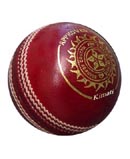

About Cricket: What is Cricket?
About Cricket Game
Explaining Cricket...
Cricket is a team sport played between two teams of eleven players. It is a bat-and-ball game played on a roughly elliptical grass field, in the centre of which is a flat strip of ground 22 yards (20.12 m) long, called a pitch. At each end of the pitch is a set of wooden stumps, called a wicket. A player from the fielding team (the bowler) propels a hard, fist-sized cork-centred leather ball from one wicket towards the other. The ball usually bounces before reaching a player from the opposing team (the batsman), who defends the wicket from the ball with a wooden cricket bat. Another batsman (the "non-striker") stands in an inactive role near the bowler's wicket.Generally, the batsman attempts to strike the ball with the bat, and run to the other end, exchanging places with his partner, scoring a run. However, he can attempt to run without hitting the ball, and vice versa. While the batting team scores as many runs as it can, the bowling team returns the ball back to either wicket. If the ball strikes a wicket before the batsman nearer to that wicket has reached safety, then the batsman is out, or "dismissed". The batsman can also be out by failing to stop the bowled ball from hitting the wicket, or if a fielder catches the ball before it touches the ground. Once the batsmen are not attempting to score any more runs, the ball is "dead" and is bowled again.
Once out, a batsman is replaced by the next batsman in the team. As there must always be two batsmen on the field, the team's innings ends when ten batsmen are out, and the teams exchange roles. The number of innings, and possible restrictions on the number of balls in each, depend on the type of game played. At the end of the match - of which there are several definitions - the team that has scored more runs wins. In first-class cricket, a draw can result if the team to bat last fails to match the required total before a time limit is reached. This can add interest to one-sided games by giving the team in the worse position an incentive to play for a draw. This is distinct from a tie, which results if scores are level at the completion of both teams' innings.
Objective and results
 Cricket is a bat and ball sport. The objective of the game is to score more runs than the opposing team. A match is divided into innings during which one team bats and one team fields. The word "innings" is both singular and plural in cricket usage.
Cricket is a bat and ball sport. The objective of the game is to score more runs than the opposing team. A match is divided into innings during which one team bats and one team fields. The word "innings" is both singular and plural in cricket usage.
If the team batting last is dismissed while their total score is n runs less than that of their opponents, they are said to have lost by n runs. If, in a two-innings match, one team is dismissed twice with a combined first- and second-innings score less than their opponents' first-innings score, then the winning team has no requirement to bat again and they are said to have won by an innings and n runs, where n is the difference in score between the teams.
 If the team batting last is dismissed with the scores exactly equal then the match is a tie; a tie is a rare result, particularly in matches of two innings a side. If the team batting last reaches their target, they are said to have won by n wickets, where n is the number of wickets the opposition still needed to take in order to dismiss them. If the time allotted for the match finishes before either side can win, then the game is a draw.
If the team batting last is dismissed with the scores exactly equal then the match is a tie; a tie is a rare result, particularly in matches of two innings a side. If the team batting last reaches their target, they are said to have won by n wickets, where n is the number of wickets the opposition still needed to take in order to dismiss them. If the time allotted for the match finishes before either side can win, then the game is a draw.
If the match has only a single innings per side, then a maximum number of deliveries for each innings is often imposed. In this case the side scoring more runs wins regardless of the number of wickets lost, so that a draw cannot occur. If this kind of match is temporarily interrupted by bad weather, then a complex mathematical formula known as the Duckworth-Lewis method is often used to recalculate a new target score. A one-day match can be declared a "No-Result" if fewer than a previously agreed number of overs have been bowled by either team. This can occur if an interruption makes a resumption of play impossible, for example an extended period of bad weather.
Laws of Cricket
The game is played in accordance with 42 laws of cricket, which have been developed by the Marylebone Cricket Club in discussion with the main cricketing nations. Teams may agree to alter some of the rules for particular games. Other rules supplement the main laws and change them to deal with different circumstances. In particular, there are a number of modifications to the playing structure and fielding position rules that apply to one innings games - like ODIs and Twenty20 Matches - that are restricted to a set number of fair deliveries.- Cricket Laws index
- Laws regarding Cricket Players And Cricket Officials
- Laws regarding the Cricket Playing Field
- Laws regarding Cricket Match Structure
- Laws regarding Batting and Scoring Runs in Cricket
- Laws regarding Bowling and Dismissals in Cricket
- Laws regarding Fielding And Wicket-Keeping in Cricket
- Laws regarding Other Important Cricket Roles
- One Day International Cricket Laws



